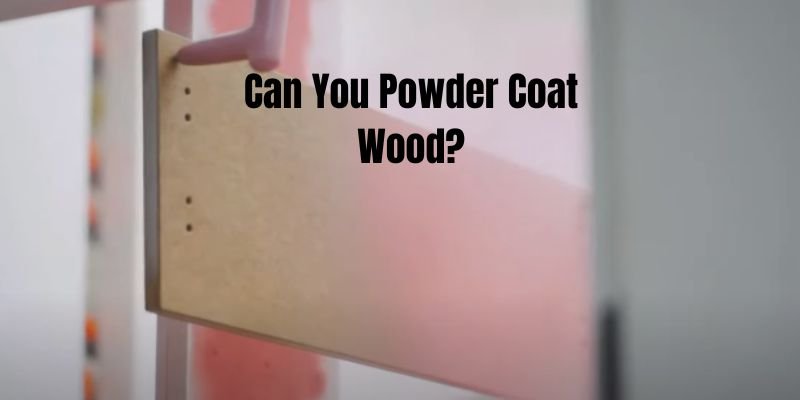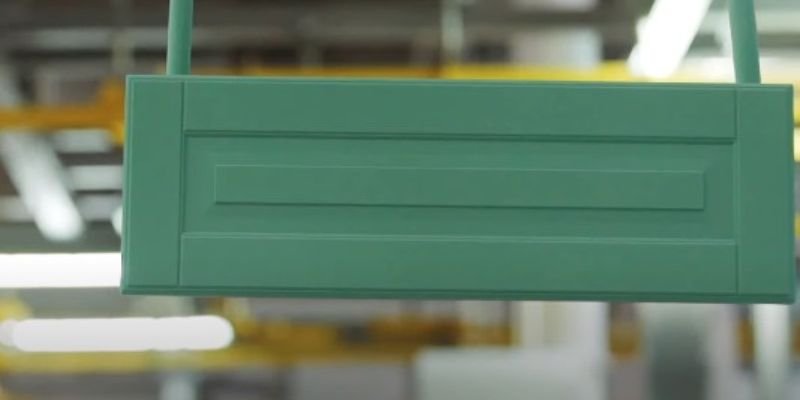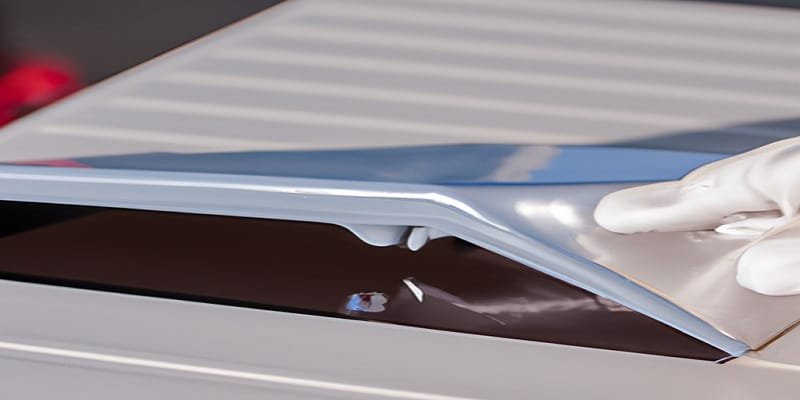Can You Powder Coat Wood? Absolutely! Powder coating isn’t just for metal anymore. Imagine giving your wooden creations a sleek, vibrant, and durable finish that defies convention. Get ready to explore the exciting world where woodworking meets powder coating magic!

Can You Powder Coat Wood?
If you’re wondering whether can wood be powder coated, the answer is yes. Powder coating is a popular finishing process for metal products, but it can also be used on wood surfaces.
Powder coating is a dry finishing process that involves applying a fine powder to a surface and then curing it in an oven. The result is a durable, long-lasting finish that is resistant to chipping, scratching, and fading.
Read More: Can you powder coat aluminum?
Challenges of Powder Coating Wood
While powder coating wood is possible, it does come with some challenges. Wood is a porous material, which means that it can absorb moisture and expand or contract over time. This can cause the powder coating to crack or peel, especially if the wood is exposed to extreme temperatures or humidity.

Another challenge of powder coating wood is that it requires a low-temperature curing process. Traditional powder coating ovens typically operate at temperatures of 350-400 degrees Fahrenheit, which can be too high for some types of wood. High temperatures can cause the wood to warp or crack, which can ruin the finish.
Advancements in Low-Temperature Powder Coating
Fortunately, advancements in low-temperature powder coating have made it possible to powder coat wood without damaging the material. Low-temperature powder coating ovens operate at temperatures as low as 200 degrees Fahrenheit, which is much safer for wood surfaces.
In addition to low-temperature curing, there are other techniques that can be used to improve the adhesion and durability of powder coating on wood. For example, some powder coating manufacturers offer special primers that are designed to bond with wood surfaces. These primers can help to seal the wood and create a smooth, even surface for the powder coating to adhere to.
While powder coating wood does come with some challenges, it is possible with the right techniques and equipment. If you’re considering powder coating a wood surface, be sure to work with a professional who has experience with this process and can help you achieve the best possible results.
What Types of Wood Can Be Powder Coated?

Powder coating is a popular finishing technique that can be used on a variety of materials, including metals, plastics, and even wood. However, not all types of wood are suitable for powder coating. Here are some of the most commonly used types of wood that can be powder coated:
MDF
Medium-density fiberboard (MDF) is a popular choice for powder coating because it is inexpensive, readily available, and easy to work with. MDF is made from wood fibers that are bonded together with resin, which makes it strong and durable. However, MDF is not as strong as solid wood, and it can be prone to warping and cracking if it is not properly sealed.
Plywood
Plywood is another popular choice for powder coating. It is made from thin layers of wood that are glued together, which makes it strong and stable. Plywood is often used in furniture and cabinetry because it is less expensive than solid wood but still provides a good amount of strength and durability.
Solid Wood
Solid wood can also be powder coated, but it is not as commonly used as MDF or plywood. Solid wood is more expensive than other types of wood, and it can be difficult to work with because it is prone to warping and cracking. However, if it is properly sealed and prepared, solid wood can provide a beautiful and durable finish.
Other Types of Wood
Other types of wood, such as particleboard and chipboard, are not recommended for powder coating because they are not as strong or durable as MDF, plywood, or solid wood. Additionally, some types of wood, such as cedar and redwood, contain natural oils that can interfere with the powder coating process. If you are unsure whether a particular type of wood is suitable for powder coating, it is best to consult with a professional.
Process of Powder Coating Wood

Preparation
Before powder coating wood, it is important to prepare the surface properly. Start by sanding the wood to remove any rough spots or splinters. Then, use a tack cloth to remove any dust or debris from the surface.
Next, apply a primer to the wood to help the powder coating adhere better. Make sure to choose a primer that is compatible with both wood and powder coating. Apply the primer evenly and let it dry completely before moving on to the next step.
Application
Once the primer is dry, it is time to apply the powder coating. You can use an electrostatic spray gun to apply the powder coating evenly to the wood surface. Make sure to wear protective gear, such as a respirator, gloves, and safety glasses, to avoid inhaling the powder or getting it on your skin.
After applying the powder coating, bake the wood in an oven at a temperature and time specified by the powder coating manufacturer. This will help the powder coating to cure and adhere to the wood properly.
Curing
After baking, let the wood cool down completely before handling it. Once cooled, inspect the wood surface for any imperfections or defects. If necessary, you can touch up the powder coating with a small brush or spray gun.
Overall, powder coating wood can be a great way to protect and enhance the appearance of wood surfaces. By following the proper preparation, application, and curing steps, you can achieve a durable and attractive finish on your wood projects.
Benefits of Powder Coating Wood
Durability
Powder coating is a highly durable finish that can significantly increase the lifespan of your wood products. The powder coating process creates a strong, protective layer that is resistant to scratches, chips, and other types of damage. This makes it an ideal choice for wood products that are exposed to harsh weather conditions or heavy use.
Compared to traditional paint finishes, powder coating is much more resistant to fading, chalking, and peeling. This means that your wood products will maintain their color and finish for longer periods of time, even when exposed to the elements. Additionally, powder coating is resistant to corrosion and rust, making it an ideal choice for wood products that are used in humid or wet environments.
Environmental Impact
Powder coating is an environmentally friendly finish that is free from harmful solvents and VOCs (volatile organic compounds). This means that it is a safer option for both the environment and for those who work with it. Additionally, the powder coating process produces less waste than traditional painting methods, making it a more sustainable option.
Powder coating is also highly efficient, with a high transfer rate that minimizes overspray and waste. This means that you can achieve a high-quality finish with minimal material usage, making it a cost-effective option in the long run.
Powder coating is a durable and environmentally friendly finish that can significantly increase the lifespan of your wood products. By choosing powder coating, you can enjoy a high-quality finish that is resistant to damage and corrosion, while also minimizing your environmental impact.
Drawbacks and Limitations
Cost
Powder coating wood can be more expensive than traditional wood finishing methods. The cost of the powder coating material itself is generally higher than other types of coatings. Additionally, the equipment required to apply the powder coating can be costly. This includes the powder coating gun, the curing oven, and the necessary safety equipment.
Limitations of Use
Powder coating wood is not suitable for all types of wood. Softwoods, such as pine and cedar, are more prone to warping and cracking when exposed to the high temperatures required for powder coating. Additionally, wood with intricate designs or carvings may not be suitable for powder coating, as the powder may not be able to reach all areas of the wood.
Powder coating wood also has limitations in terms of the size and shape of the wood that can be coated. Large or irregularly shaped pieces of wood may not fit in the curing oven, or may require multiple coats to achieve full coverage.
Overall, while powder coating wood can provide a durable and attractive finish, it is important to consider the cost and limitations before deciding to use this method of wood finishing.
Frequently Asked Questions
Can wood cabinets be powder coated?
Yes, wood cabinets can be powder coated. However, not all types of wood are suitable for powder coating. Softwoods such as pine and cedar are not recommended as they tend to absorb moisture and may cause problems during the coating process. Hardwoods such as oak, maple, and birch are better options as they are more durable and can withstand the high temperatures used in the powder coating process.
Can you powder coat a wooden door?
Yes, you can powder coat a wooden door. However, the door must be properly prepared before the coating process. This includes sanding the surface to remove any rough spots or imperfections, and applying a primer to the surface to ensure proper adhesion of the powder coating. It is also important to note that wooden doors may require more maintenance than metal doors, as they are more susceptible to moisture and temperature changes.
How does powder coating compare to traditional painting for wood?
Powder coating offers several advantages over traditional painting for wood. First, powder coating is more durable and long-lasting than traditional paint. It is also more resistant to chipping, scratching, and fading over time. Additionally, powder coating is environmentally friendly as it produces less waste and emits fewer harmful chemicals than traditional painting methods. However, powder coating may be more expensive than traditional painting, and may require more preparation and specialized equipment to perform.
Final Thoughts
So, can you powder coat wood? Absolutely! Embrace the possibilities that powder coating brings to your woodworking endeavors, transforming ordinary timber into extraordinary works of art. Unleash your creativity, experiment with textures and colors, and embark on a journey that marries tradition with a cutting-edge finish.
Read More: Can You Powder Coat Brass?


